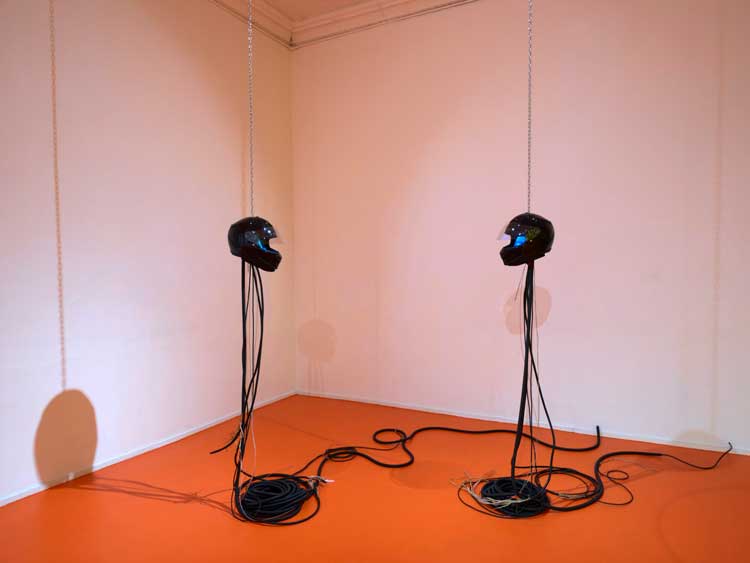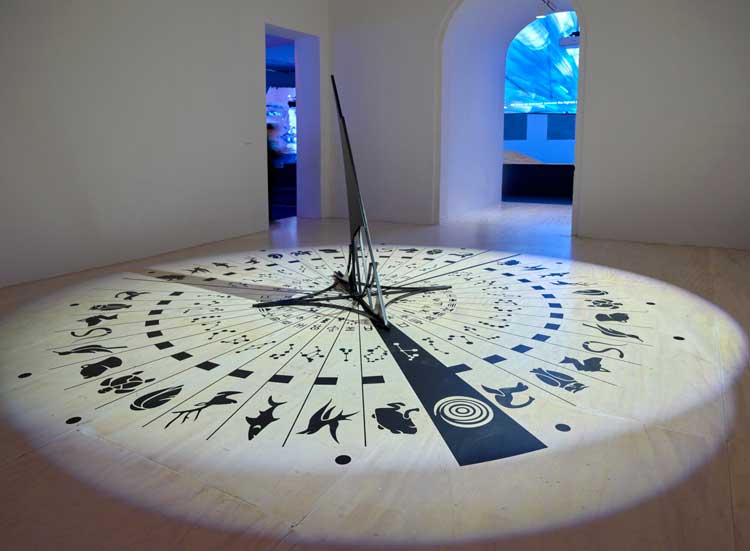-2024.jpg)
MoMA PS1, New York
6 November 2025 – 16 March 2026
by SABINE CASPARIE
Arriving at MoMA PS1 from Manhattan at dusk, the famous skyline in my mind’s eye, the transition to Ayoung Kim’s version of Seoul, with its fast and furious backdrop of highways and traffic and buildings, feels smooth and natural. Delivery Dancer Codex is her first institutional exhibition in the US, after winning the prestigious Guggenheim Award earlier this year. It is also the first time that the video installations comprising Kim’s Delivery Dancer trilogy are presented together.

Ayoung Kim. Delivery Dancer’s Sphere. 2022. Single-channel video, 25 min. Courtesy the artist and Gallery Hyundai.
Using a combination of live-action footage, animation and videogame simulation, Delivery Dancer’s Sphere (2022) follows a young, female delivery driver called Ernst Mo (her name an anagram of “monster”), on a mission to deliver a series of unidentified products as fast and efficiently as possible. As Kim tells us at the preview, she conceived of the film during the Covid pandemic, struck by the idea that delivery drivers were one of the few mobile entities in a deserted Seoul in lockdown; she befriended a female driver, who invited her to come on a “liberating” ride on the back of a motorbike. Spiralling shapes suggest the driver’s routes through the maze-like city, dispatched by an entity called the “Dance Masters”. The camerawork in the highway footage is hectic, as if we are speeding along with Ernst Mo, accompanied by a mysterious, ambient soundscape. At times, the traffic lights and lit-up motorways blur into pure lines of colour, kaleidoscopic and spinning around like a fortune wheel.

Ayoung Kim. Delivery Dancer’s Sphere. 2022. Single-channel video, 25 min. Courtesy the artist and Gallery Hyundai.
“South Korea’s liberal tendencies mean an environment where everyone is always striving for the optimal, in terms of time, speed and productivity,” Kim explains. Ernst Mo’s navigation leads her to places with sterile names such as “fulfilment centre” and “digital tower”, but interestingly the idea of optimalisation is realised in a tonality that is not just hi-tech, but also dreamy and melancholic. A glitch in the system allows Ernst Mo to become caught between the cracks of time and meet En Storm, who is her identical double from a parallel world, intermittently a nemesis and a romantic interest. “Every time you appear, time slows down,” the voiceover whispers, before the two female drivers ride off on a motorbike together.

Ayoung Kim. Delivery Dancer’s Arc: 0º Receiver, 2024. Three-channel video, 32 min. Courtesy MoMA PS1. Photo: Roz Akin.
Time is one of the main themes in Kim’s work – how time has been viewed throughout history, our personal notions of it, as well as its metaphysical concerns. Characters are said to stretch, defy and protect time; time fields are collapsing and timekeepers from the past intrude on the present. Delivery Dancer’s Arc: O° Receiver (2024) and Delivery Dancer’s Arc: Inverse (2024) are counterparts, providing a deeper exploration of the protagonists’ story. Ernst Mo and En Storm find themselves in a futuristic, vertical city called Novaria – which reminded me of the underground silo in the eponymous TV series Silo – populated by giant bioluminescent insects providing air and light. The time from the past starts to encroach on the present, Ernst Mo and En Storm fight, and (spoiler warning!) Mo ultimately kills off her double to survive.

Ayoung Kim. Delivery Dancer’s Arc: Inverse. 2024. Three-channel high-definition video (colour, sound). 27 min. Courtesy MoMA PS1. Photo: Roz Akin.
Delivery Dancer’s Arc: Inverse (2024) is the exhibition’s most striking installation. Three giant screens are suspended at angles above a stage-like construction clad in orange carpet, and from a distance it looks like a spaceship about to rise from the Earth, the screens like giant sails, the people sitting or lying on the built-in benches, its unsuspecting passengers. Kim uses generative AI to create the visuals in which faces change seamlessly from real to animated, and AI is also embedded inside the films to create different visuals each time it is played. Kim’s virtual worlds are beautifully realised, but at times I find myself distracted by the fragmented visuals: too much artifice, not enough story. The abstract ruminations about multiverses and time start to override the queer delivery drivers’ quest, one in which I had really become invested, with its combination of sociopolitical and metaphysical ideas and its tender human story. I can’t help but look around the room to peek at the other people lying on the orange “stage” and staring up at the screens.

Ayoung Kim. Ghost Dancers A. 2022. Helmets, video, tablets, wire, corrugated tube, and metal chain. Courtesy MoMA PS1. Photo: Roz Akin.
Various sculptures embody motifs from the film. The strongest are Ghost Dancers A (2022) and Ghost Dancers B (2022). In A, two real helmets, suspended from the ceiling, face each other like two figures beheaded by technology, the fleeting highway of Seoul showing in the helmets’ visors. In B, two life-sized female bikers are fighting, surrounded by broken glass, a very 21st-century version of figurative sculpture, touching on issues of labour, race, gender and queerness. These works perfectly convey the duality between the embodiment of the physical and the emptiness of the virtual.

Ayoung Kim. Ghost Dancers B. 2022. Mannequins, costumes, helmets, LED masks, gloves, boots, reinforced cases, and tempered glass. Courtesy MoMA PS1. Photo: Roz Akin.
This dissonance of real and fictional, physical and virtual, lends the complete trilogy an intriguing ambiguity. Kim has said in interviews that she intends the Delivery Dancer works to continue, their endlessness mirroring the infinite options of AI itself, but the danger is that a multitude of films starts to feel as overwhelming as a multitude of universes, the ideas behind them a little too “meta” and experimental for a museum setting. What Kim manages to do so well in the first video, Delivery Dancer’s Sphere,is use mind-blowing, complex and seductive visuals and make us feel the speed of the sleek delivery driver, the chill from the cold cement of the highway, the glow of the warm lights in the surrounding buildings, the meeting of two lost souls amid the desolate rows of stacked boxes in an anonymous warehouse.

Ayoung Kim. Delivery Dancer’s Arc: Inverse (detail). 2024. Three-channel video, lighting installation, random video playback and lighting synchronization control program, sundial sculpture, graphic sheets, and circular screen. Courtesy MoMA PS1. Photo: Roz Akin.
At its strongest, Kim’s work – like that of another great artist working in speculative film, Cao Fei – manages to infuse the digital sphere with a sense of longing, kindness and hope. Kim’s compelling, queer delivery drivers are quietly rebellious, replacing cold, clinical navigation systems with their own subtle navigation tools, guiding us to those brief moments of human connection ever harder to find in our hyper-digitalised lives.
• The film Delivery Codex Dancer (2022) and Evening Peak Time is Back (2022), a wall-sized vinyl, are currently on view at A Year in Art: 2050, Tate, London.
Ayoung Kim: Delivery Dancer Codex
A trilogy of video works featuring two queer, female delivery drivers in Seoul, Ayoung Kim’s Deliv...
The Tate’s landmark exhibition presents a fascinating story, but could have done more to capture t...
Known as a gallerist to the likes of Rauschenberg and Rothko, Betty Parsons spent her weekends makin...
In a powerful new show of painting, sculpture and film, the artist brings folkloric traditions and m...
Robert MacBryde and Robert Colquhoun: Artists, Lovers, Outsiders
The two men from working-class Scottish backgrounds met at art school and became inseparable. This e...
Push the Limits: Culture Strips to Reveal War
A diverse group of works in this exhibition at Fondazione Merz show how contemporary art responds to...
Artes Mundi 11 Prize and Exhibition
Against a background of divisive global politics and hysteria around migration, the six artists shor...
At Aberystwyth Arts Centre, Anawana Haloba has staged an “experimental opera”, as she terms this...
Jumana Emil Abboud – interview
Drawing on folklore, mythmaking and storytelling, Jumana Emil Abboud articulates the strains placed ...
Rhiannon Hiles, chief executive, Beamish Museum – interview
Winner of the world’s largest museum prize, the £120,000 Art Fund Museum of the Year, Beamish, an...
Whether depicting women at work, children playing on the beach or locals at prayer Anna Ancher’s l...
Wright of Derby: From the Shadows
The National Gallery reunifies Joseph Wright of Derby’s trio of candlelit masterpieces, while reve...
Wayne Thiebaud: American Still Life
A luscious selection of sweets, cakes and pies seduce us at this, American painter Wayne Thiebaud’...
A Story of South Asian Art: Mrinalini Mukherjee and Her Circle
This visually thrilling exhibition is a revelation. Pivoting around Mrinalini Mukherjee, it also cel...
Following in the female surrealist tradition, Holly Stevenson makes cathectic objects from clay, whi...
Vision and Illusion: Architectural Photographs by Hélène Binet
A research project by the University of Oxford into Jewish country houses, tracing their history and...
American artist Lucy Raven’s eloquent new film tracks a remarkable undoing, as the dammed Klamath ...
Grace Ndiritu: Compassionate Rebels in Action. Sit-in #5
This show is about taking inspiration from alternative practices and sharing and defining what knowl...
Candice Lin’s cardboard labyrinth is at once playful and sinister, conveying the relentless drip-f...
The pioneering interdisciplinary artist takes us on a tour around Prophetic Dreaming, Suzanne Treist...
Gilbert & George: 21st Century Pictures
The provocative pair turn the Hayward Gallery into a carnival of misrule...
Shadowscapes: Heaney, JMW Turner and Quantum
Spilling over floors, walls and balconies, as well as in framed works on walls, artist Libby Heaney...
Joy Gregory: Catching Flies with Honey
This survey show, spanning four decades, brings together more than 250 works from this innovative Bl...
Georg Baselitz: A Life in Print
Provocative German painter Georg Baselitz shows his dizzying mastery of print in this capacious, ove...
Sculptor Andrew Kinghorn talks about architecture, colonialism, how his extensive travels through As...
The first edition of this now historic event opened the world to the City of Angels in 2012, tailing...
Sophie Barber: Mackerel sky, mackerel sky, never long wet, never long dry
A new exhibition of Sophie Barber’s work, the first in her hometown of Hastings, has her distincti...
The Costume House: The Inside Story of Cosprop from A Room with a View to ...
Film historian Keith Lodwick’s beautifully illustrated and educational book charts the success of ...
Norwegian artist Sandra Mujinga creates an eerie, gallery-spanning installation with green light for...
This show looks at the lasting influence of Marie Antoinette, the young queen whose love of fashion ...